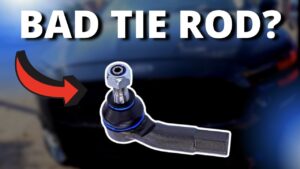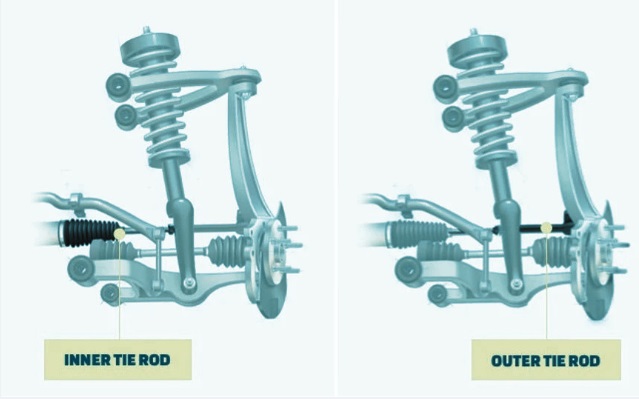There are different categories of steering systems, such as rack and pinion steering and recirculating ball steering; all of these systems share common parts that facilitate an effortless steering process. Tie rods work when we turn the steering wheel, and they are located on the front wheel, making a connection between the steering gear and the steering knuckle. A tie rod end can become faulty and affect the operation of vehicles. Here, we cover features for the tie rod end and find different symptoms of a bad tie rod end.
What are tie rod ends?
- Tie rod ends are the main part of the vehicle’s steering system. It used to make a connection between the steering rack and a steering knuckle on the front wheels, which controls wheel movement when we move the steering wheel.
- A single tie rod assembly comes with two tie rod parts, internal and external, that transmit steering force from the steering rack to the wheels.
-
- Internal or inner tie rods are connected with the steering rack and move according to the signal obtained from the steering. It delivers movement to the outer tie rod.
- The outer tie rod is connected with the inner tie rod, which directly connects with the steering knuckle, converting the motion of the steering wheel to the motion of the wheel on roads.
Tie rod working
- As we know, the tie rod is the main component of the car steering system. Its main work is to make the connection between the vehicle and the steering wheel. steering connection with the wheel.
- The main types of steering systems are rack and pinion, ball, or mechanical steering wheel rotation.
- rack and pinion steering system has a simple working process. When the steering wheel is turned, the pin that is configured with the steering axis moves over the rack.
- The rack, connected with two front wheels, moves according to the wheels’ rotations.
- •The steering rod transmits power from the steering rack to the steering arm that is used for wheel movement.
- A rotary or mechanical ball steering system is complicated than a rack and pinion. The mechanical system has a gearbox.
- When we turn the steering wheel, the steering axle moves many gears to control the tie rod.
- The steering wheel moves through articulated arms based on driving features. For a rack and pinion system, the steering rack is connected with tie rods that are connected with steering arms.
- steering rod connection of the steering system with the wheels. Either these systems are complicated but have important parts connecting the axis.
- The steering wheel is an important part of the driving system. Our steering system does not work without a steering wheel.
- The bar works as a pivot point between the steering system arm and the steering wheel. The outer bar end has adjustable features that allow varying the tie rod length for alignment of the car.
- So, the tie rod is important and provides movement of the wheels when moving and steering.
Symptoms of a Bad Tie Rod End
Tire Wear
- Uneven tire wear occurs if you have a broken tie rod. We can inspect it visually; by checking that high wear exists on one side and not the other side, it means the tie rod is damaged.
- But if uniform wear exists, it means the tie rods are in proper working condition. For solving uneven or excessive wear, get the service of a technician.
Front End Improper Alignment
- There is a main feature of the rod that steers the vehicle and moves it straight. Different parts cause the vehicle to face misalignment; a further worn tie rod can become loose, and as a result, the front end of the vehicle also becomes misaligned.
- To solve this error, get the service of a technician since it is caused by improper car handling.
Read more: Symptoms Of Bad Timing Chain
Vibration in the Steering Wheel
- Since tie rods make the connection of the steering wheel with the front wheels, if you are facing any issue with steering, that means you have damaged tie rods.
- The main indication for steering faults is a shaking steering wheel and looseness in the steering wheel.
- Vibrations increase when we drive with faulty steering. Solve this error as soon as possible.
Knocking Sound
- If you hear a knocking or clunking sound from the front of the car when turning at low speeds, it is a sign of bad tie rods. When they become loose, tie rods rattle at joints, which produces noise.
- If the boot protecting the tie rod joint is also broken, it has dust particles that cause a grinding sound when we steer.
- To remove the cause of sound, get services from a professional.
Is it possible to drive with a damaged tie rod?
- If you drive with a faulty tie rod, it affects steering and vehicle handling. If you are facing difficulty turning the vehicle in a certain direction, it means you have a bad tie rod.
- Solve as many faults as possible to avoid any damage.
Causes of Faulty Tie Rod Ends
- Normally, tie rod ends are damaged with time, but it is an exceptional case.
- Older cars and some trucks come with grease fittings for tie rods, so they need proper grease; if not, they get serious damage.
- When we apply grease that has a chance of leaking through cracks, and road grime mixes with the grease, that can damage joints fast.
- Adding a high amount of grease in a joint causes bursts, so apply grease carefully.
- So if facing difficulty for car movement, get the service of a technician.
Read also:What are the symptoms of a bad engine control module
Frequently asked questions
How long do tie rod ends last?
- Tie rod ends work for many years, about between 50,000 and 100,000 miles, but it is based on driving conditions, roads, and how much time you drive the car.
- Proper inspection can avoid signs of any wear and damage.
Is alignment needed for replacing tie rod ends?
- Yes, it is suggested to do wheel alignment when replacing tie rod ends. Changing rod ends has an effect on vehicle alignment that causes tire wear and bad handling without accurate alignment.
- When you replace the tie rod, replacement alignment of the wheel is included, which increases optimal performance.
Should you replace all tie rods at once?
- It is good to replace both tie rod ends on the same axle if one is worn. Replacement of a pair of tie rods simultaneously helps to make the required wear and handling in a balanced way.
- If one tie rod is damaged, there is a chance the other tie rod end also needs replacement.
- But replacement of tie rods over both axles at the same time is not important, since the back side of most vehicles does not come with tie rods until the vehicle comes with rear-wheel steering.
How do mechanics diagnose tie rod problems?
- For this purpose, a dry park check test is performed. In this test, a mechanic lies below the car with a flashlight, and a helper turns the wheel back and forth, which helps find the tie rod ends that are developed.
What does a bad tie rod sound like when turning?
- • A knocking sound generated from the front of the vehicle when turning at low speed is a sign of faulty tie rods.
- When they become loose, tie rods rattle at joints and cause noise.

